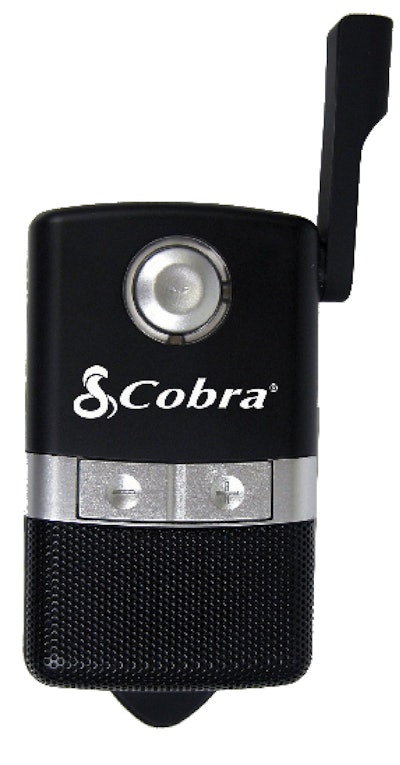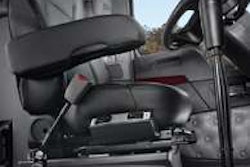 Noise-cancellation technology is especially helpful when driving through a shipper’s terminal with the window open.
Noise-cancellation technology is especially helpful when driving through a shipper’s terminal with the window open.And no noise. A Bluetooth headset meets the challenges of in-cab communications with little extra cost.
Laws are increasingly restricting cell phone use while driving for safety reasons. And conducting conversations on cell phones is often difficult because of sound distortion and background noise.
While cell phones often have plug-in headsets, the wiring can get tangled, and wearing such headphones can be uncomfortable. Mounting the phone close enough to the headset can also be a problem.
An effective solution is a wireless headset that communicates with your cell phone and dampens noise. In recent years, Bluetooth technology has emerged to make this possible.
“Bluetooth is an open wireless protocol for exchanging data over short distances from fixed and mobile devices, creating personal area networks,” says Chuck White, marketing director at DAS Inc., which sells MobileSpec headsets.
When you use a Bluetooth headset, your cell phone handles all communications with the cell tower – dialing, voice reception and transmission. The headset then uses Bluetooth technology to carry both your voice and that of your caller, and to allow you to answer a call and adjust the volume. You can handle incoming calls by touching buttons on the earphone. With most late model phones, you can activate a headset without changing your arrangement with your cell service provider or purchasing any other equipment.

The Bluetooth.com website explains that in creating a personal area network, the technology “detects other devices in the spectrum and avoids the frequencies they are using.” This means that you get a quiet and secure path for communication.
One important feature of a Bluetooth device is the position of the microphone and whether or not it is adjustable. “VXI has carefully selected a noise-canceling microphone and incorporated it into a design that is optimized for noise-canceling,” says Daryle Lamoureux, VXI product marketing manager. This includes “a flexible microphone boom to ensure that the user can place the microphone close to his mouth. The microphone picks up the user’s voice and not all the background noise.”
An adjustable microphone is probably ideal, but it should sit close to your mouth so the system can easily separate your voice from background noise.
Basic wearing comfort and reversibility are other issues to consider. Many sets of headphones are intended for continuous use. For example, Lamoureux says VXI originally designed its headphones for use in call centers. And White says many professional drivers prefer “over-the-head headsets because they balance even lightweight frames, offer comfortable ear cushions, provide boom microphones for near-mouth sound quality, and are usually wearable on either ear.”
Volume range is also important, especially if your cab is noisy or if you often need to work outside in a noisy environment. Make sure you can adjust the volume high enough for your needs without producing distortion. And listen to the sound fidelity for quality.
 Cobra makes the T5 Bluetooth visor speakerphone with noise-cancellation technology for those who don’t want to use a headset.
Cobra makes the T5 Bluetooth visor speakerphone with noise-cancellation technology for those who don’t want to use a headset.If headsets are uncomfortable, you can opt for an over-the-ear design or a hands-free visor speakerphone. But background noise is likely to be more of a worry with a speakerphone, even with a noise-cancellation feature. Lamoureux says VXI’s Xpressway convertible headset has three wearing styles – over-the-head, behind-the-neck and over-the-ear.
Another important issue is the convenience of using the controls. Driving hands-free loses its appeal if you become distracted fumbling around, looking for a volume control or trying to answer a call. You might choose to get a headset that has volume, answer and end controls on the headset itself, like the MobileSpec Silencer RX Noise Canceling Bluetooth model. The Cobra CBTH1 features a multi-function button that allows answer/end, redial and voice-activated dialing. The volume buttons also help with transferring calls, placing on hold or three-way conference calling.
Operating distance from your cell phone may be critical if you leave your cell in the cab while doing tasks outside the truck. “The cell phone has to be within a range of around 30 feet, depending on the Bluetooth device,” says Bethany Steinbach, a salesperson at Aries Manufacturing. That’s the typical range, though the VXI BlueParrot B250XT permits distances of up to 66 feet.
Make sure you have enough talk time on a single battery charge to get you through one on-duty cycle. The VXI BlueParrot B250-XT and Xpressway models, for example, offer 16 hours.
Also look at the charging options that come with the device. The ideal is the capability to use 120-volt AC and 12-volt DC (as supplied in your truck’s on-dash charging socket or cigarette lighter), as well as USB-port charging.
As to cost, the biggest factor is whether you want noise cancellation technology. The Cobra CBTH1, which Steinbach says was designed for truckers, goes for about $90, while the CBTH2, which does not have noise cancellation technology, sells for about $60. You can also buy headsets that plug into the cell phone for less, but for ease of use during driving and walking around, Bluetooth technology may be worth the higher cost.
Lamoureux says, “A trucker should expect to spend up to $120 for a high-quality, professional-grade headset. In terms of performance, noise-canceling and audio quality are must-have features.”
Many models are offered in truck stops. For example, Barjan Marketing Director Steve Stombaugh says his company sells Motorola, Cobra, BlueParrot and Jabra at Travel Centers of America, Petro, Flying J and Love’s. n
Try it on for size, function
When shopping for a headset, note:
• Does the earphone cushion adequately protect your ear from pinching or other pressure?
• How adjustable is the earpiece?
• Can you adjust it or the frame of the device so it fits over your ear?
• Can the microphone be adjusted so you can reverse the headset?
• If so, can you switch ears to combat fatigue periodically?
• The ear cushion gradually loses resiliency. Does the manufacturer sell replacements?
How to connect
A new Bluetooth headset might not initially recognize your cell phone and connect with it. “The phone has to have Bluetooth capability,” says Bethany Steinbach of Aries Manufacturing. “All newer phones are coming out with this technology.”
To activate:
• Charge the headset completely.
• Turn on your cell phone’s Bluetooth option.
• Turn your headset to Bluetooth mode. Check the instructions for your device’s alert.
• Once the headset is ready to be paired, it is your phone’s job to connect to it. Connection varies by phone, so check your device’s instructions.
• Next, select the unit the headset has found.
• For initial pairing, enter a code. Check your instructions to find the code for your headset. Once this is done, you are likely to get an indication that the connection has been made.
When you are paired to the headset, all calls will go directly to the headset. To make calls, you still need to use the phone to dial.
How the bad sound disappears
Not all headsets have noise cancellation technology, but those that do use a cool technology to blot out distracting sounds and leave voices untouched.
Chuck White of DAS explains that every sound has a distinct wave shape:
“Noise-canceling technologies first rely on small microphones that detect the sounds in a given environment. A digital signal processor determines what sound wave is required to cancel the unwanted sound wave and then it creates that sound and amplifies it through speakers or headphones.
“Imagine a ‘positive’ sound and a ‘negative’ sound created at virtually the same time, and these two sounds cancel themselves out.”










